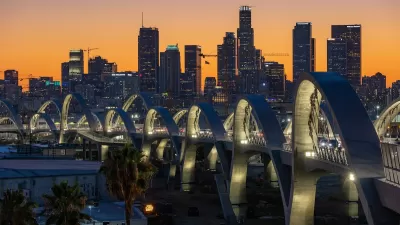Proposed designs for a possible football stadium in downtown L.A. leave a lot to be desired -- both architecturally and urbanistically, according to this review.
Los Angeles Times architecture critic Christopher Hawthorne takes a look at the proposals and finds few redeeming qualities.
"To a large extent, the lack of architectural ambition evident in the designs comes as little surprise. Anyone who has spent much time downtown knows AEG is hardly a patron of innovative architecture.
But there were glimmers, when AEG began to explore the idea of building a stadium downtown, that it might take a more active interest in architecture and urban design this time around. In part this had to do with the involvement of Casey Wasserman, who has teamed with AEG's Tim Leiweke and Ted Tanner on the stadium planning and who is fairly savvy about contemporary architecture. Early in the process, AEG held preliminary conversations with a small number of architects who are significantly more adventurous than the ones it later engaged formally. But conservatism won out in the end.
The proposals for the stadium - which will be squeezed between Staples Center and the L.A. Convention Center, and require some convention facilities to be rebuilt, presumably on AEG's dime, along Pico Boulevard - fall short on more than just aesthetic grounds. They are also fairly timid in their thinking about the future of downtown."
FULL STORY: There's nothing groundbreaking in downtown L.A. stadium design proposals

Maui's Vacation Rental Debate Turns Ugly
Verbal attacks, misinformation campaigns and fistfights plague a high-stakes debate to convert thousands of vacation rentals into long-term housing.

Planetizen Federal Action Tracker
A weekly monitor of how Trump’s orders and actions are impacting planners and planning in America.

In Urban Planning, AI Prompting Could be the New Design Thinking
Creativity has long been key to great urban design. What if we see AI as our new creative partner?

King County Supportive Housing Program Offers Hope for Unhoused Residents
The county is taking a ‘Housing First’ approach that prioritizes getting people into housing, then offering wraparound supportive services.

Researchers Use AI to Get Clearer Picture of US Housing
Analysts are using artificial intelligence to supercharge their research by allowing them to comb through data faster. Though these AI tools can be error prone, they save time and housing researchers are optimistic about the future.

Making Shared Micromobility More Inclusive
Cities and shared mobility system operators can do more to include people with disabilities in planning and operations, per a new report.
Urban Design for Planners 1: Software Tools
This six-course series explores essential urban design concepts using open source software and equips planners with the tools they need to participate fully in the urban design process.
Planning for Universal Design
Learn the tools for implementing Universal Design in planning regulations.
planning NEXT
Appalachian Highlands Housing Partners
Mpact (founded as Rail~Volution)
City of Camden Redevelopment Agency
City of Astoria
City of Portland
City of Laramie




























